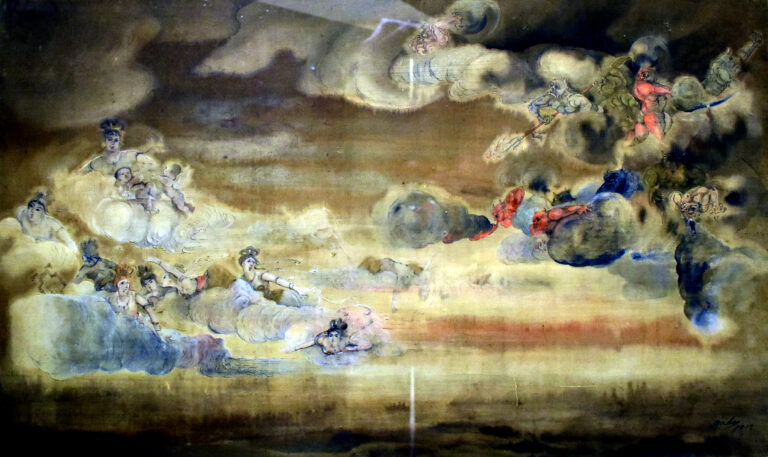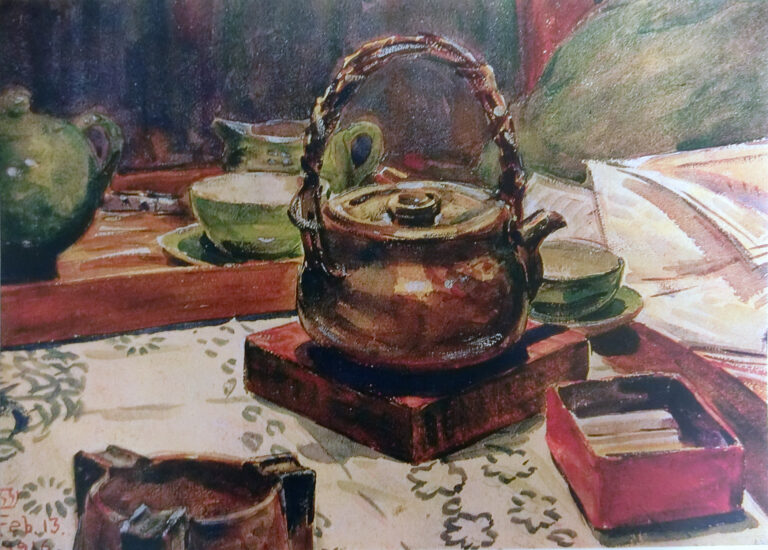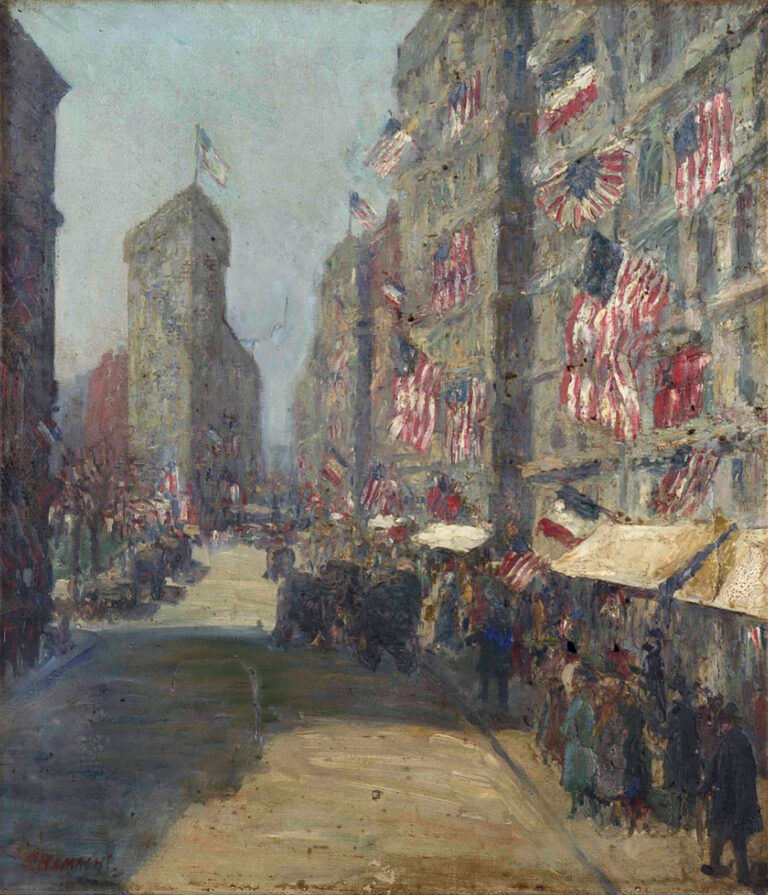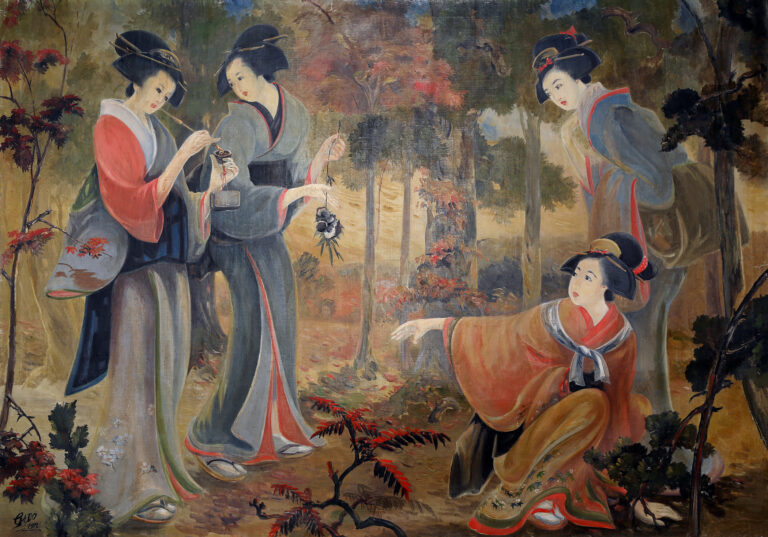1917-1918 Exhibitions of the Japanese Art Association
Located on the East Coast of the United States, New York City was an immigration hub for Europeans that prospered as a center of economy, industry, and culture at the end of the 19th century. In the early 20th century, a Japanese community formed there which mainly consisted of government officials and business people. However, artists from art schools in Japan were also drawn to NYC as a temporary relay point to Europe, as were Japanese artists studying in American art schools who had previously immigrated for work.
Around 1915, these artists formed a group called the New York Nihon Bijutsu Kyokai (New York Japanese Art Association). According to a Japanese-language newspaper published in the city, the initiation of the New York Japan Art Association was held at the Nippon Club in November 1915. This meeting of artists was presided over by Ko Ashiwara, a painter who had graduated from the Western-style painting department of the Tokyo School of Fine Art. The meeting was attended by Consul General Takashi Nakamura, Dr. Jokichi Takamine (President of the Nippon Club), and Takanosuke Seko (Manager of the Mitsui & Co.). The presence of Japanese Association executives and Japanese business executives at the meeting suggests that the New York Japanese Art Association was supported by local Japanese businesses in the area. Dr. Takamine made a speech at the meeting in which he stated his hope that Japanese artistic creation would stimulate American interest–and therefore develop trade in–Japanese ceramics and porcelain. As a result, Japanese companies with branches in New York likely sought out Japanese artists to produce East Asian-style works of art intended for export to Western countries.
In March 1917, there was an exhibition of the New York Japanese Art Association at the Yamanaka Gallery. The exhibition featured 75 oil paintings, watercolors, architectural drawings, and photographs by I. Kagawa, T.K. Gado, T. Wake, S. Shimotori, K. Ashiwara, T. Ono. S. Hamachi, M. Uwagawa, M. Tsuchiya, I. Takanosu, and T. Kikuchi.
Yamanaka & Co. was a prominent Japanese antique art gallery founded by Sadajiro Yamanaka in Osaka, Japan, with branches in New York, Boston, and London. Clients included the Rockefeller and Vanderbilt families, Charles Lang Freer, Isabella Stewart Gardner, Ernest Fenollosa, H.O. Havemeyer, and other collectors who laid the foundation for Japanese Art collection in U.S. museums from the late 19th to 20th centuries. Therefore, one might be tempted to assume that the 1917 exhibition of the New York Japanese Art Association included works devoted to the East Asian art style.
“The annual exhibition of the Japanese Art Association is now on at the Yamanaka Galleries, 254 Fifth Ave, through March 24, and is made up of paintings, drawings, and photographs by young Japanese artists resident here, whose work is especially interesting given the fact that it represents an endeavor to adapt themselves to Western methods and ideas. The work has a distinct commercial value apart from its artistic merit. At least two of the artists are fashion designers for a well-known publishing house, but the blending of Western and Oriental art is so agreeably apparent in their designs that one loses the impression of purely commercial creations—the architectural drawings form an exciting part of the exhibit. ‘A Fireplace for a Dining Room’ by I. Takanotsu and the two drawings by T. Ono, ‘Suburban House in America’ and ‘Combination Style of Interior,’ are good examples of a modification of Japanese Concepts for Western use.”
(“Young Japanese Artists’ Display” American Art News, March 17, 1917).
On the other hand, New York Shimpo wrote,
“Among the oil paintings, Mr. Hamachi painted in the American style, and Mr. Uwakawa’s work is in the French and Western style portraits. The Japanese subject matter has lost its artistic ground, which should express the highest emotion, and is merely a mere reminiscence of the motherland. The works of Mr. Shimotori, Mr. Wake, Mr. Gado, and others can also be described as such. They seem to be pandering to Americans’ exotic tastes, their yearning for the Orient”.
(Kuro Okada, “Bijutsu Techo: Seeing an Exhibition of Works by Japanese Artists in New York],” New York Shimpo, March 21, 1917)
Nichibei Shuho reported,
“Mr. Takanosu’s work is a Westernization of a purely Japanese-style dining room that is tasteful, and Mr. Ono’s painting of an alcove in a country house is a good example of a Japanese-Western blend. Mr. Wake’s ‘decoration room’ and ‘Japanese woman’ are good colors that attract people. Mr. Tuchiya’s Screen is an interesting design that Westerners like. Mr. Hamachi’s ‘Tea Pot’ and Mr. Ashiwara’s ‘The Night Train on the L line’ Mr. Hamachi’s portrait are not praiseworthy.”
(“Review of the Japanese Art Exhibitions,” Nichibei Shuho, March 24, 1917)
At the time this exhibition was held, the American art world presented works of the Academy School, which used realistic techniques, as well as works of modernism from movements such as Cubism and Futurism that had emerged in Europe. Compared to the American art exhibitions of the time, the New York Japanese Art Association’s exhibition was marked by orientalist works and adaptations of Western taste, which were criticized as outdated and imitations of Japonism.
One year after the exhibition at the Yamanaka Gallery, the New York Japanese Art Association held its second exhibition at the McDowell Club from February 2 to February 10, 1918.Fifty-five oil paintings were exhibited, including works by K. Ashiwara, T.K. Gado, S. Hamachi, I.E. Hori, K. Inukai, K. Kimoto, Y. Kuniyoshi, G. Sakaguchi, S. Shimotori, George Tera, M.T. Tsuchiya, and M. Uwagawa.
“Very few show that decorative simplicity is so much appreciated in Japanese art, ‘Take Gari’, by T. K. Gado, shows a group of Japanese ladies. Still, the background is Western, and the result is rather a ‘melange’. S. Hamachi’s nudes have good flesh qualities and his ‘Winter Day’’ is well handled. George Tera has several portraits charming in color and sympathetically rendered, his ‘Red Sleeves’ making a striking color combination of scarlet, dark blue, and dull gold. The large canvas by M. Uwagawa, ‘The Flower,’ is fresh in color and decoratively treated. The still life by S. Shimotori is an unpretentious little canvas, but it holds attention with its harmony of color and line.”
(“Art” New York Tribune,Feb. 3, 1918)
Nichibei Shuho wrote,
“Shimotori’s ‘Still Life’ and Tera’s ‘Portrait’ seem to be complete, but the rest of the works are pale sentimentalism or imitations of late Impressionism, full of irony. The guide, Kashiro, seemed disappointed with the exhibition, which he described as ‘outdated and incomplete’.
(Koushiro, ‘New York Art World: A Note on Seeing Two Exhibitions,’ Nichibei Shuho, February 8, 1918)
The New York Shimpo reported
“There is what is called ‘Ashitori Sumo,’ […] Although sumo and art should not be discussed at the same time, it is regrettable that some of the works in this exhibition have a similar atmosphere. Japanese artists make use of their culture very much. However, they are overused Orientalism. When I see a work that an American art journalist (I dare to say “news reporter”) points out as a fine piece of art that is so similar to a sumo wrestler’s victory in a foot wrestling match, I cannot help but laugh.”
(Okada Kuro, “Nihon Bijutsu-kai Manroku,” The New York Shimpo, February 13, 1918).
The exhibitions of the New York Japanese Art Association were full of works exhibiting oriental taste that Westerners preferred and works that did not entirely depart from the imitation of Western painting. Thus, it can be said that Western painting by the Japanese in the 1910s was in its earliest stages.





